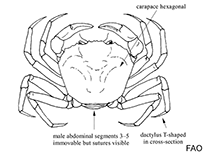Chaceon ramosae Manning, Tavares & Albuquerque, 1989
Royal crab| Native range | All suitable habitat | Point map | Year 2050 |

|
| This map was computer-generated and has not yet been reviewed. |
| Chaceon ramosae AquaMaps Data sources: GBIF OBIS |
Upload your photos
Google image | No image available for this species;
drawing shows typical species in Geryonidae.
Google image | No image available for this species;
drawing shows typical species in Geryonidae.
Classification / Names Common names | Synonyms | CoL | ITIS | WoRMS
Malacostraca | Decapoda | Geryonidae
Environment: milieu / climate zone / depth range / distribution range Ecology
Benthic; depth range 601 - 1228 m (Ref. 105069). Subtropical; 21°S - 35°S, 52°W - 39°W (Ref. 105421)
Distribution Countries | FAO areas | Ecosystems | Occurrences | Introductions
Southwest Atlantic: Brazil, from Rio de Janeiro to Rio Grande do Sul.
Length at first maturity / Size / Weight / Age
Maturity: Lm ? range ? - ? cm Max length : 15.8 cm CW male/unsexed; (Ref. 105069)
Short description Morphology
A large Chaceon, CL to 143 mm, CW to 158 mm in adults, with 5 anterolateral teeth on the carapace and dorsoventrally depressed dactyli on the walking legs. Carapace 1.1 to 1.2 times broader than long. Median pair of frontal teeth separated by U-shaped sinus. Distance between submedian frontal teeth less than distance between them and lateral frontal teeth. Second, third, and fourth anterolateral teeth obsolete in adults, second and fourth smallest of all; distance from first to third tooth less than that from third to fifth tooth. Carapace with distinct raised ridge mesial to fifth anterolateral tooth, carapace surface finely granular, especially posterolaterally, smooth only at hepatic regions. Suborbital tooth short and broad in adults, not extending to level of lateral frontal teeth. Cheliped merus with sharp tooth subdistally, lacking distal tooth or angled lobe; carpus roughened dorsally, usually with irregular, curved granular ridge extending from middle of proximal margin to inner spine, anterior margin of carpus with at most an angled lobe but no spine; propodus with at most distal angled projection dorsally. Meri of walking legs with at most indistinct distal, dorsal tooth. Dactyli of walking legs depressed, height at midlength less than width. Fifth leg: merus usually less than 5.0 times (range 4.6-4.9 in adults, 6.4 in juvenile male) times longer than high, length 0.65 to 0.66 cb in adult; carpus with line of sharp granules dorsally; propodus length 4.1 to 4.3 times height in adult, 5.1 times height in juvenile, longer than dactylus.
Deep-water species (Ref. 105069). Epibenthonic. Found on muddy and muddy-sandy bottoms. Scavenger and predator; likely to be an opportunistic carnivore (Ref. 104380).
Life cycle and mating behavior Maturity | Reproduction | Spawning | Eggs | Fecundity | Larvae
Main reference
References | Coordinator | Collaborators
Manning, R.B., M.S. Tavares and E.F. Albuquerque. 1989. (Ref. 105069)
IUCN Red List Status (Ref. 130435)
CITES status (Ref. 108899)
Not Evaluated
CMS (Ref. 116361)
Not Evaluated
Threat to humans
Harmless
Human uses
Fisheries: commercial
| FishSource |
Tools
More information
Internet sources
BHL | BOLD Systems | CISTI | DiscoverLife | FAO(Publication : search) | Fishipedia | GenBank (genome, nucleotide) | GloBI | Gomexsi | Google Books | Google Scholar | Google | PubMed | Tree of Life | Wikipedia (Go, Search) | Zoological Record



